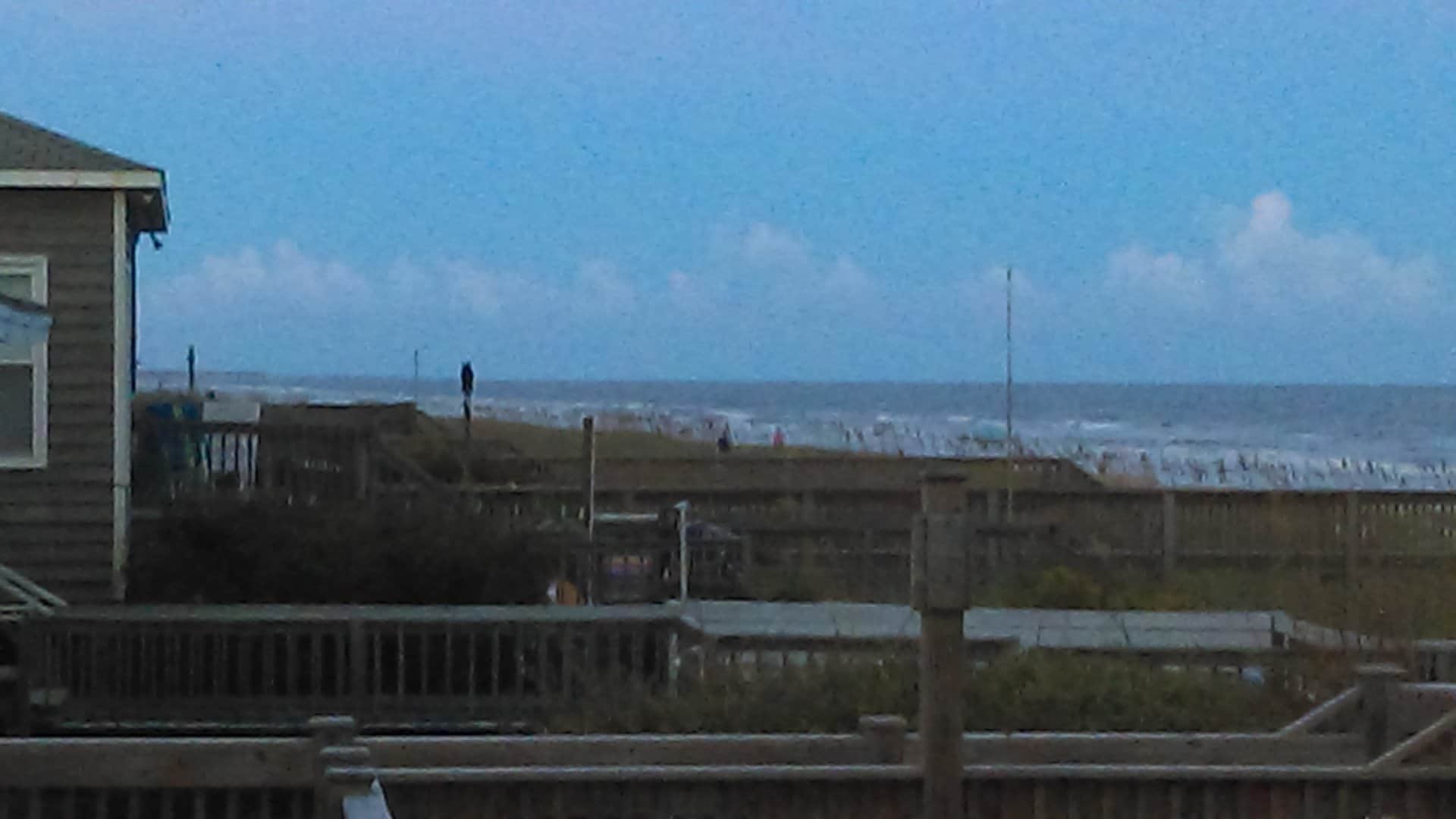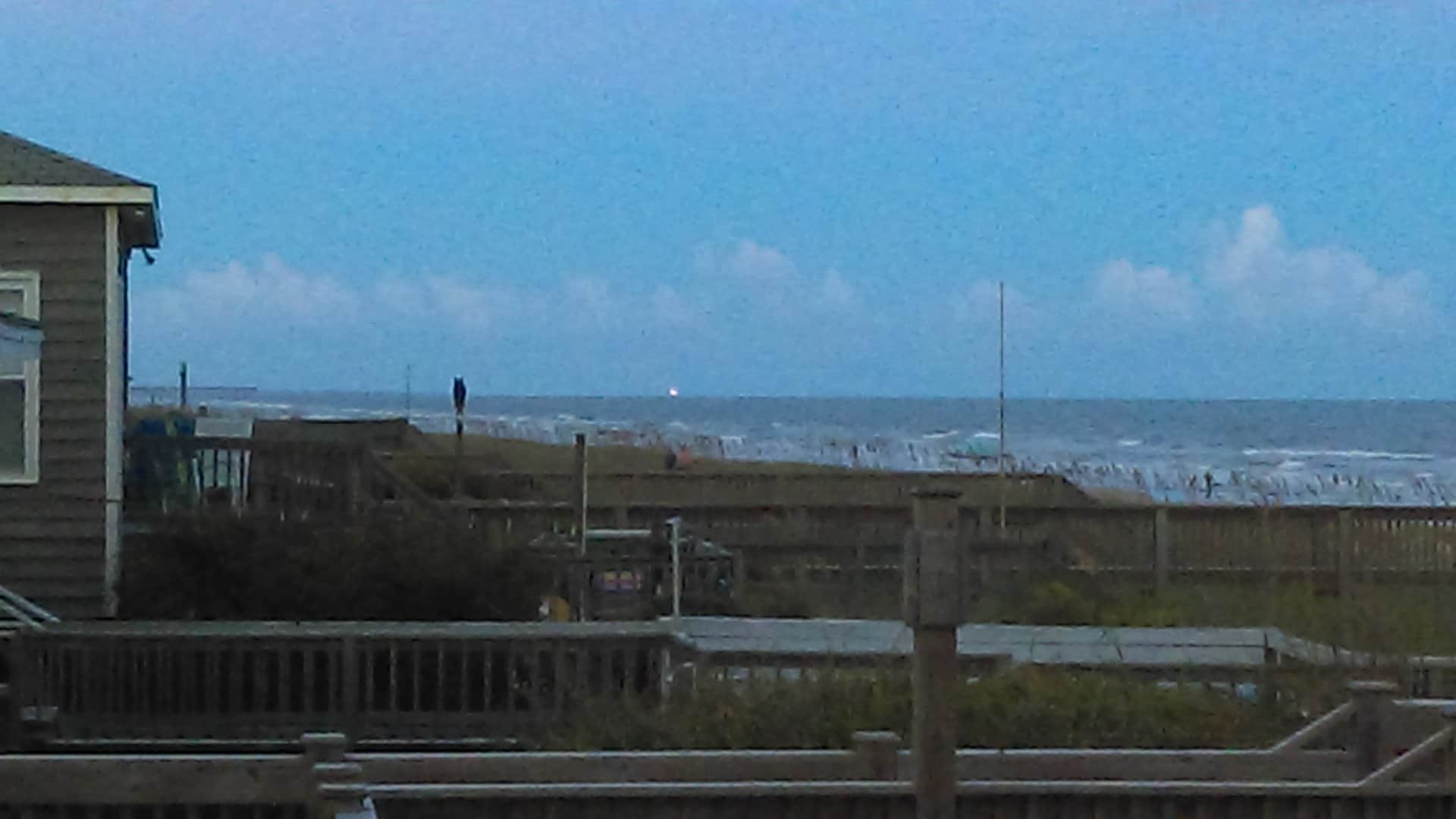Here are two pictures from the porch of a beach house at Holden Beach, NC. Holden Beach is near the southern edge of coastal North Carolina, so the beach faces south instead of east. Look for the difference in the two pictures.
The light on the horizon in the second picture is from the Oak Island Lighthouse. From my phone coordinates to the listed coordinates of the lighthouse, the ellipsoidal distance, according to NGS Inverse, is 27,349.8 meters, or 14.8 nautical miles. Geodetic azimuth is 93-29-48. It's kind of neat to see the beach running east-west and the lighthouse to the southeast.
We're essentially at zero elevation, so the ellipsoidal height is the geoid height, about minus 34 meters. Elevation factors here are 1.000005xx, so using the ellipsoidal distance as the ground distance is only about 5 ppm in error.
The pictures were taken at about 8:30 PM with a 6 mega-pixel camera. I was amazed that they turned out as well as they did.
You guys and girls deal with horizon and refraction every day, but here's a link from San Diego State University that shows some pretty good math for distances with refraction.. http://www-rohan.sdsu.edu/~aty/explain/atmos_refr/horizon.html
And here's more about the Oak Island Lighthouse if you're interested. http://www.lighthousefriends.com/light.asp?ID=352
Also, Tables 12 and 13 of Bowditch have some interesting data and an explanation of how they were calculated.
I wonder why my family thinks I'm a math nerd?
Because they are wise, observant people, quite obviously.
p.s. It takes one to know one.
MathTeacher Your first link does not work ( the one at sdsu); can you fix it?
JOHN NOLTON
John, that link takes the cake. I can't fix it.
I found it on 8-11, read the article, and copied the link. It was written by Andrew T. Young, an adjunct in the astronomy department ar SDSU. He was not listed on their faculty page on the 11th, but his work was still on the SDSU server.
His International Astronomy Union bio still listed him as SDSU faculty on the 11th, so I thought the link would be valid. Apparently, though, he's gone from SDSU and, at some time during the last few days, his work has been wiped from their server.
Andrew Young has written some great papers and this was one of them. I did not download it, opting just to use the link to refer to it. If anyone finds it, maybe they will share.
MathTeacher, post: 386222, member: 7674 wrote: John, that link takes the cake. I can't fix it.
I found it on 8-11, read the article, and copied the link. It was written by Andrew T. Young, an adjunct in the astronomy department ar SDSU. He was not listed on their faculty page on the 11th, but his work was still on the SDSU server.
His International Astronomy Union bio still listed him as SDSU faculty on the 11th, so I thought the link would be valid. Apparently, though, he's gone from SDSU and, at some time during the last few days, his work has been wiped from their server.
Andrew Young has written some great papers and this was one of them. I did not download it, opting just to use the link to refer to it. If anyone finds it, maybe they will share.
Is this it?
Loyal that must be it. But I guess we will hear from MathTeacher soon to verify that fact.
Andrew T. Young can't be all bad; his #32 reference is Geodesy by G. Bomford.
JOHN NOLTON
No,that's not it. The paper is on Atmospheric Refraction. Here's a substitute site that's pretty good. Where it gives references, go to those.
http://mathscinotes.com/2013/08/distance-to-the-horizon-assuming-refraction/
Ol' Pennsylvania Jack is good, but lacks the derivation and diagrams that Andrew Young published:
http://www.pajack.com/stories/pitts/viewdistance.html
Go to table 12 in Bowditch (PDF page 689) and click on the question mark. It takes you to a brief but good explanation for distance to the horizon without refraction. The table 13 note is below it and includes refraction.
http://www.dacust.com/navigation/pdf/Bowditch.pdf
I'll keep looking for the Andrew Young paper. It is excellent, but MIA.
MathTeacher I hope you can find the missing paper (I know how that is). Since you like stuff like that look at " Manual of Geodetic Triangulation",
Special Pub. #247,1959 (NGS). Page 285-287.
Special Application of Vertical-Angle Measurements:
Determination of Height of Station by Observing Sea Horizon
And;
Determination of Distance to Breaker by Observing Angle of Depression.
I have used both several times in my life.
JOHN NOLTON
JOHN NOLTON, post: 386245, member: 225 wrote: MathTeacher I hope you can find the missing paper (I know how that is). Since you like stuff like that look at " Manual of Geodetic Triangulation",
Special Pub. #247,1959 (NGS). Page 285-287.
Special Application of Vertical-Angle Measurements:
Determination of Height of Station by Observing Sea HorizonAnd;
Determination of Distance to Breaker by Observing Angle of Depression.I have used both several times in my life.
JOHN NOLTON
Wow, Special Publication 247!
I have an original bound copy of that on my book shelf!
A great resource.
Loyal
Thanks, John and Loyal. I see in the formula, rho, the radius of curvature of the earth, multiplied by 2. That was one of the points covered in Professor Young's paper. Refracted light follows a curved path with a different radius of curvature than that of the earth. He has an excellent diagram that communicates the situation perfectly. He also very clearly cautions that refraction varies widely across the surface of the ocean.
One of the other links for the Oak Island Lighthouse said that it is visible for 24 miles while the Wikipedia article, I think, says 16 nautical miles. My calculation of ellipsoidal distance from the beach house was almost exactly 15 miles, which I converted to nautical miles, and, as the picture shows, the light is just barely above the horizon. But the picture does not capture the intensity of the light, and it is very bright. It was this discrepancy in numbers that set me off on the quest for perfection.
One rediscovery I made is that my TI-89 calculator, circa 2002 or so, uses International Feet for its programmed conversions between feet and meters. I haven't looked to see what my HP 50g does. It doesn't matter here, but it would matter in converting state plane coordinates from meters to feet in a US Survey Foot state.
Heavens! My family is right! I'm a terminal math nerd!
Let's hold off on that terminal part for a while. We need you to hang around here and keep us on course.
Here you go. This is a good bit of the missing paper. The class web pages on the Rohan server at SDSU were deleted back in May. I have no idea how I got something to something that used to be there.
Here's an archived version. Note the curved path in one of the diagrams and the 7/6 factor for the radius of curvature of refracted light.
http://mintaka.sdsu.edu/GF/explain/atmos_refr/horizon.htm l"> https://web.archive.org/web/20131717132700/http://mintaka.sdsu.edu/GF/explain/atmos_refr/horizon.html
You know, we all need to be aware that anything stored electronically never, ever goes away completely.
What I have been lied to.
http://www.seerockcity.com/gallery/entry/views
in this modern age we tend to lose touch with nature
years ago I got into singlehanded offshore sailing, before consumer grade GPS. we had LORAN, but electronics in marine atmosphere can be fickle.
we used to calculate distance to lights, using a sextant, accounting for curvature and refraction over the horizon. observations on a lurching deck, then hand calcs on a small boat in gale force winds and high seas can be challenging. I kept a small library of tables and charts aboard, even after I got my Garmin 45 in 1991+/-
BTW, that 45 still works.
MathTeacher, post: 386335, member: 7674 wrote: Here you go. This is a good bit of the missing paper. The class web pages on the Rohan server at SDSU were deleted back in May. I have no idea how I got something to something that used to be there.
Here's an archived version. Note the curved path in one of the diagrams and the 7/6 factor for the radius of curvature of refracted light.
http://mintaka.sdsu.edu/GF/explain/atmos_refr/horizon.htm l"> https://web.archive.org/web/20131717132700/http://mintaka.sdsu.edu/GF/explain/atmos_refr/horizon.html
You know, we all need to be aware that anything stored electronically never, ever goes away completely.
MathTeacher,
I couldn't tell after a quick check whether you'd found Young's SDSU website, http://aty.sdsu.edu , which includes this page, Distance to the Horizon without having to go through archive.org.
Thanks, Melita. I did not find the aty. site. I followed a very tortured path of identifying email servers and searching in convoluted ways. That led me to the deletion note and then to the archive.
Whenever I can't get to a webpage, the first thing I do is start chopping off bits from the URL so see if I can get to a more general or index site. It doesn't work that often, but occasionally it's a useful technique.
mkennedy, post: 386480, member: 7183 wrote: ...it's a useful technique.
Indeed it is. I found Mintaka in the email address for Dr. Allen Shafter, the head of the astronomy department. When I played around with url's with Mintaka, I ran across the note that stuff was being moved from the Rohan server. So, Mintaka is a server, like Rohan, and a few trials later, I found the archived copy.
Back in the innocent days of the web, you could find CEO's emails through Yahoo Finance. Company write-ups there always included an email address for their stockholder relations person. That address gave you the format for names in the company email system and, voila, you had the CEO's email address.
Not that easy nowadays, but still doable, just takes longer.





